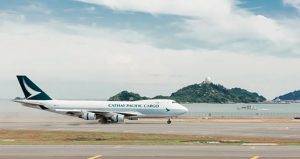Bloomberg
It could be one of the world’s most expensive white elephants. Hong Kong opened its new, third runway at its airport, part of a HK$141.5 billion ($18 billion) project that will increase its footprint by 50%, adding 650 hectares (1,606 acres), equivalent to the size of Gibraltar.
Also under construction is a HK$20 billion entertainment, retail and commercial complex being built by local conglomerate New World Development Co that will be larger than New York’s Grand Central Terminal.
It’s all designed to solidify the city’s role as a global aviation hub, but comes at a time when the government’s flight bans and quarantine rules have crushed demand for air travel to and from Hong Kong.
The policies “seem to have been almost designed to try to kill off Cathay Pacific and the Hong Kong hub,†said Robert Boyle, founder of London-based aviation advisory Gridpoint
Consulting. Only 545,000 passengers passed through the airport in the first five months of 2022 versus 31.4 million in the same period of 2019.
After more than two years of isolation, Hong Kong was “off the map†as a global hub, the head of the International Air Transport Association said.
“Every day that passes it becomes more difficult for Hong Kong,†IATA director general Willie Walsh said last month, speaking at an industry summit. “I think it’s going to be a really hard job for Hong Kong to regain its former glory.â€
Hong Kong announced it would suspend a system that banned airline routes that brought infected passengers to the city. The policy had led to the temporary cessation of 100 flight routes this year, discouraging carriers from flying to the financial hub.
Infrastructure investments are meant for the long term, but even when the city eventually moves away from its pandemic policies, it risks losing its competitiveness to Asian rivals that have reopened their borders faster, said Natixis SA Chief Asia Pacific Economist Alicia Garcia Herrero. “Hong Kong really needs to move as soon as possible,†she said. “It’s hard to pinpoint a date of no return. We are close to that already.â€
Singapore, meanwhile, is leading the region’s air travel revival. The Southeast Asian country’s Changi Airport last month announced it will reopen two terminals that were shuttered due to Covid-19 as travel springs back faster than expected.
Hong Kong airport’s current expansion project is the biggest since the airfield opened in 1998, having been at the center of a controversy between China and the UK.
The British colonial government announced a replacement for Kai Tak, the cramped, World War Two-era airport near the city center, about a decade before the return to Chinese rule, but Beijing officials were angry about the plans to finance it.
Still, all was quickly forgiven as Hong Kong International Airport became critical in solidifying Hong Kong’s role as a global hub for aviation. By 2018, more than 74 million passengers travelled through it, compared to 29.5 million at Kai Tak in 1996.
In 2019, though, pro-democracy demonstrations rocked the city, depressing its attractiveness as a tourist destination, and then in 2020, the pandemic hit. Airport Authority Hong Kong posted a second consecutive fiscal year loss, taking its total losses during the pandemic to HK$7.4 billion. Revenue fell for a fourth straight year. Hong Kong has retained its status as the world’s busiest air cargo hub, a rare bright spot in the pandemic.
 The Gulf Time Newspaper One of the finest business newspapers in the UAE brought to you by our professional writers and editors.
The Gulf Time Newspaper One of the finest business newspapers in the UAE brought to you by our professional writers and editors.
